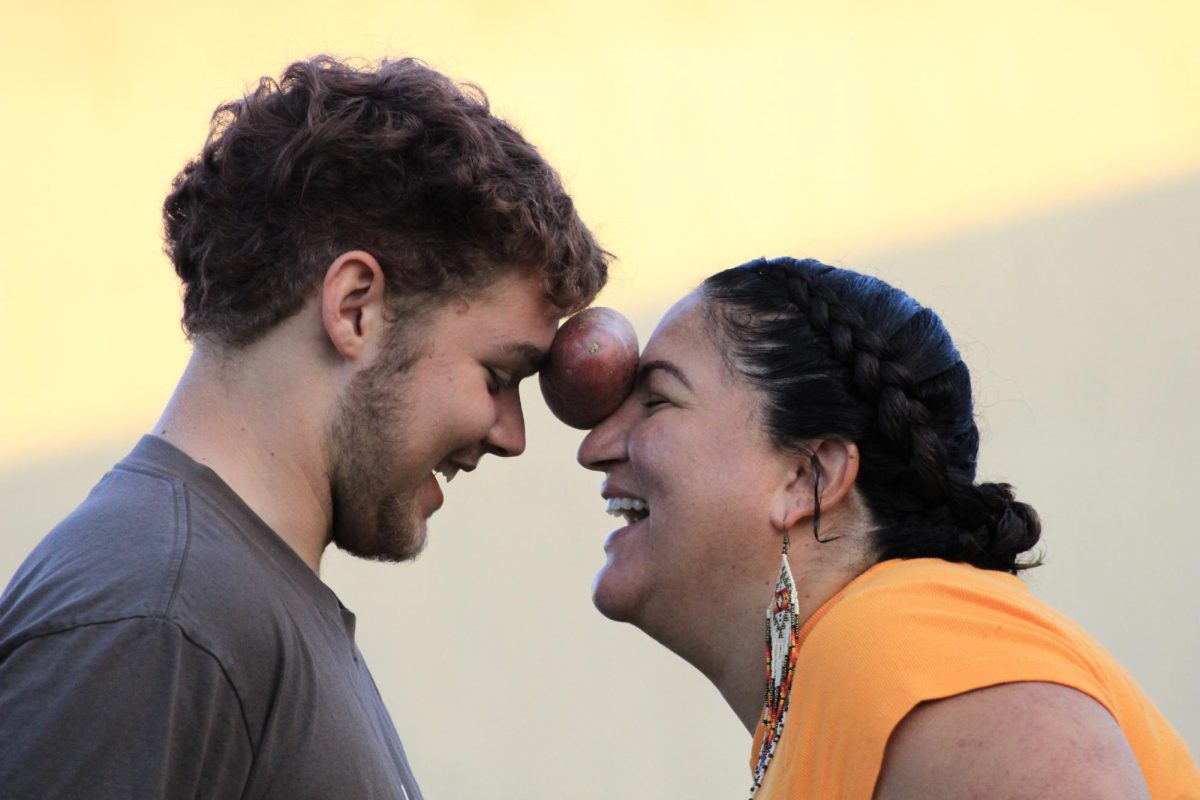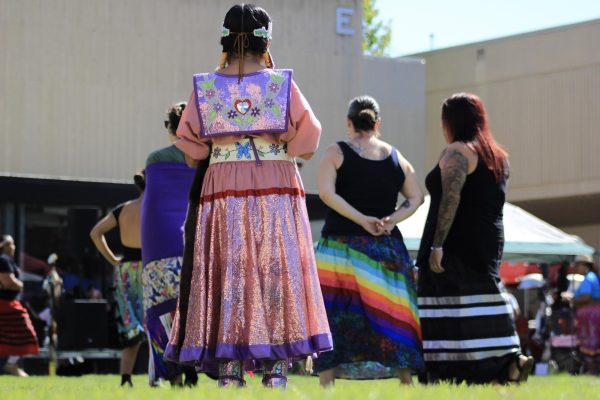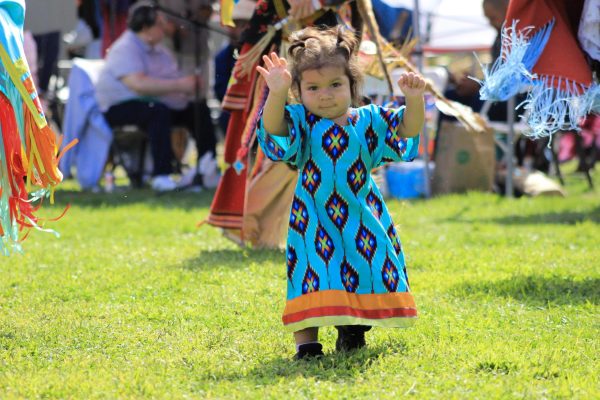
Eliot Faine
A pair competes in the Potato Dance contest, where two people hold a potato between their foreheads and dance around the arena at the NAHC Powwow at Merritt College in Oakland, CA., on September 27, 2025.
The sky was nearly cloudless at Merritt College campus on Sept. 27, the Saturday after the 2025 California Native American Day. Warm sun beamed down on the jewelers and dancers and volunteers as they prepared for the fourth annual Native American Health Center (NAHC) Powwow.
Information tents lined the paved walkway by the campus buildings. Attendees were met with friendly faces offering fresh produce, hand sanitizer, and brochures on accessing healthcare.
Vendors set up their handmade blankets, beaded earrings, and instruments in the grassy clearing. In the heart of it all was the dance arena, the main event.
From noon until 9 p.m., dancers circled the arena in friendly competition or just for fun. Elders and relatives got the best seats. Four bands of host drums flanked the arena, with singers whose voices washed over the gathering. They took turns providing music for the dancers.
Some dances were open to everyone. Some were just for the dancers in regalia. The contest dances had audience members vote for a winner.

“Cheer, clap, fart for your favorite performer,” Sitwala Carlos Calica, Tyxphum Wasqupum and Newe of the Warm Springs Reservation and Master of Ceremony for the NAHC Powwow, said after one contest with a grin.
The Powwow drew a diverse group of participants and attendees. People gathered from as near as West Oakland and as far as Canada.
More Native Americans live in the state of California than any other state in the U.S. According to 2020 national census data, one in nine Native Americans live in California cities.
The Indian Relocation Act of 1956 caused tens of thousands of Native people to relocate from their indigenous homelands into urban areas, through a program run by the Bureau of Indian Affairs. The federal government established several relocation centers in California, including San Francisco, San Jose, and Oakland, contributing to the intertribal communities that would form after this displacement.
The NAHC was established first at the Urban Indian Health Board in San Francisco in 1972. Urban Indian Health Organizations are Native-run nonprofits that contract with Indian Health Services under the U.S. Department of Health and Human Services, to provide resources directly.
When more urban Natives moved to Oakland, NAHC purchased land for a new facility in the Fruitvale neighborhood. They opened their doors in 2008 with two floors of medical care and three floors of affordable family housing.
As Tabitha Heckman of the Choctaw Nation, NAHC nurse practitioner, put it, the NAHC formed to address health disparities “for an underrepresented group of people.”
Melanie Antone-Gordon of the Tohono O’odham Tribe called Powwow a “home away from home” for the intertribal community. December will mark her third year as a community health worker with the NAHC.
“When you’re with other Natives, you know you’re gonna have that ‘Native humor;” Antone-Gordon said with a smile. “Laughter is medicine.”
And there was laughter at the Powwow. Children ran and played freely through the grass. Relatives, friends, and strangers shared stories and small talk, waiting in line at food trucks. The jingle of bells and beating drums wafted overhead with the ambrosial smoke from meat on the grill.
Dance contests carried on through the entirety of the Powwow, testing the dancers’ skill and stamina – particularly the culminating dances, the Iron Woman and Iron Man competitions. While the vendors packed up, the dancers in the arena contended for the titles.
The champion would be determined by which dancer outlasts the others. Spotters waited on the sidelines to tap out dancers who got exhausted. The host drums offer no breaks during the competition. This final dance, after eight hours of Powwow, displayed to the dancers the extent of their own strength.

“Culture is prevention,” Kelli Rutherford of the Blackfeet Nation, Human Resources at the NAHC, said. “Powwow promotes a sense of belonging and community.”